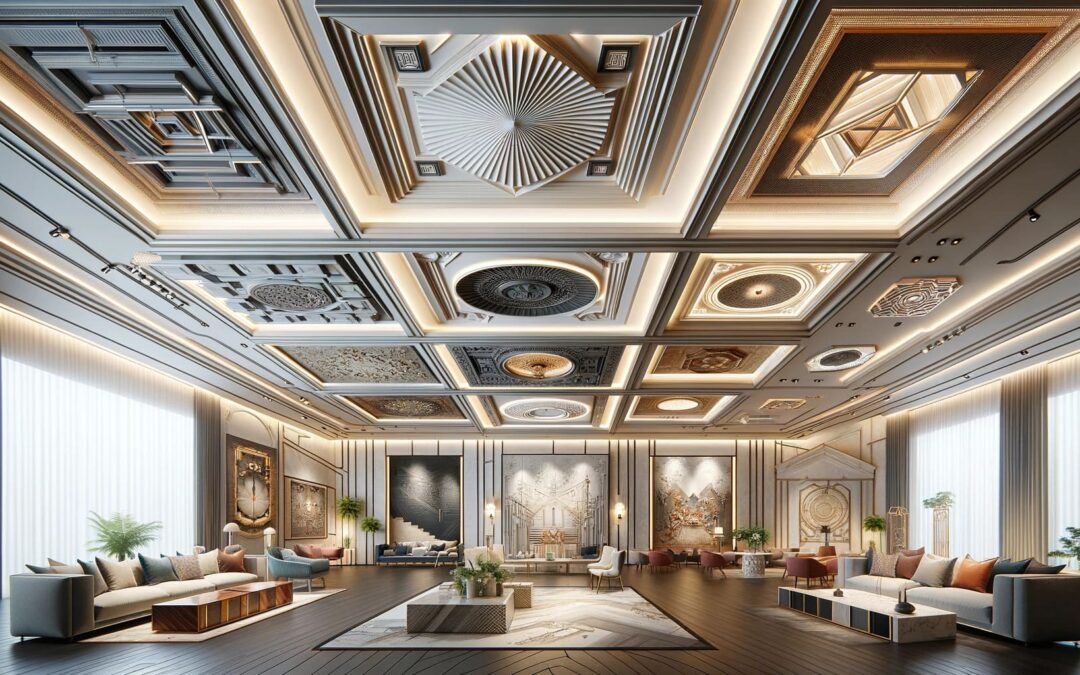When it comes to interior design, ceilings often play a secondary role compared to walls and floors. However, the ceiling is a crucial element that can transform the look and feel of a room. From creating illusions of more space to becoming the focal point of décor. The art of ceiling design encompasses various techniques and styles. Here’s a guide to understanding the key aspects of ceiling design and how to make the most of this often-overlooked space.
1. Architectural Techniques
- Coffered Ceilings: This classic design involves recessed panels framed by beams. A coffered ceiling adds depth and dimension to a room, and while traditionally used in formal settings. Modern interpretations can fit any style.
- Tray Ceilings: Also known as recessed ceilings, tray ceilings are designed to give the impression of an inverted tray on the ceiling. This style can create a sense of intimacy and can be enhanced with strategic lighting or contrasting paint colors.
- Vaulted Ceilings: Known for their high, arching design, vaulted ceilings open up a room by providing a sense of spaciousness and grandeur. They are ideal for enhancing natural light in a room.
2. Material Innovation
- Wooden Beams: Incorporating exposed wooden beams is not just for rustic or traditional settings. When paired with modern furnishings and color schemes, they can lend a warm, organic touch to a contemporary space.
- Metallic Finishes: Metal tiles or panels can add a sleek, glamorous touch to your ceiling. They reflect light, which can brightly illuminate a room, and add a modern flair that can complement any decor.
- Acoustic Tiles: Function meets design with acoustic tiles, which can reduce noise while also providing aesthetic value. Available in a variety of textures and colors, these tiles can be arranged in decorative patterns to enhance the room’s design.
3. Lighting Integration
The right lighting can turn a ceiling into a masterpiece. Integrated lighting solutions include:
- Recessed Lighting: For a clean, modern look, recessed lighting fixtures can be installed directly into the ceiling, providing even illumination without taking up space.
- Pendant and Chandelier Fixtures: Hanging fixtures work well with high or vaulted ceilings and can act as a stunning centerpiece in a room.
- LED Strips: LED strip lighting can be tucked away in coves or behind crown molding. Providing a soft, indirect light that enhances the room’s ambiance.
4. Decorative Painting and Finishes
- Faux Finishes: Techniques such as marbling, sponging, or clouding can add texture and visual interest to a ceiling, making it a striking feature of the room.
- Murals: Ceiling murals can range from subtle sky scenes to bold—artistic statements. Transforming the ceiling into a canvas that reflects personal style or artistic vision.
- Gold Leaf: For those looking to add a touch of luxury, applying gold leaf to ceiling details can elevate the space’s elegance.
5. Sustainable Practices
Sustainability in ceiling design is gaining traction. Using eco-friendly materials like recycled tiles, sustainable wood, or low-VOC paints not only benefits the environment but also improves indoor air quality.
Conclusion
The ceiling offers a fifth wall that can be used to enhance the style and functionality of any space, with a variety of design techniques and styles at your disposal. You can transform an ordinary ceiling into a defining feature of your home’s décor. Whether aiming for subtlety or statement-making, the art of ceiling design is a key component in the overall aesthetic of a space.

